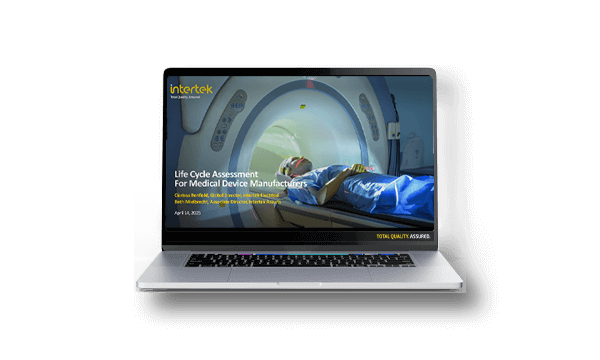Driving Sustainability in Medical Devices Through Life Cycle Assessment

05 Aug 2025
A Data-Driven Approach to Environmental Responsibility in Healthcare Innovation
Sustainability is no longer a peripheral concern, it's a strategic imperative, especially in highly regulated and innovation-driven sectors like medical devices. Whether driven by investor expectations, consumer awareness, or upcoming regulatory shifts, the push for credible environmental impact assessment is gaining momentum across the healthcare industry. For manufacturers of medical devices, the pressure to demonstrate authentic sustainability efforts is real. Greenwashing risks, intense competition, and the growing demand for transparent environmental data have made life cycle assessments (LCAs) a critical tool in defining and validating impact.
What Is Life Cycle Assessment?
Life Cycle Assessment is a comprehensive method used to evaluate the environmental impact of a product across its entire life span; from raw material extraction and manufacturing to distribution, use, and end-of-life disposal. For medical devices, this means quantifying impacts such as carbon emissions, water usage, energy consumption, material toxicity, and recyclability.
Through LCA, manufacturers can move beyond assumptions and pinpoint exactly where their biggest environmental burdens lie, whether it’s energy-intensive components, overseas shipping, or limited end-of-life options.
The Two Approaches: Top-Down and Bottom-Up
There are two main paths to begin a sustainability journey: the top-down approach, which evaluates sustainability across the entire corporate structure, and the bottom-up approach, which focuses on individual products or product families.
The top-down approach typically starts with a greenhouse gas (GHG) inventory and a materiality assessment, identifying which environmental, social, and governance (ESG) factors matter most to stakeholders. This requires cross-functional collaboration, by engaging procurement, finance, and facilities teams to gather data related to buildings, vehicle fleets, and supply chain activities.
The bottom-up approach involves a focused LCA of a specific medical device. This is particularly effective for manufacturers looking to assess and improve product design, material selection, or market positioning. It helps inform product claims and supports innovation without greenwashing.
Applying LCA to Medical Devices
Medical devices present unique challenges and opportunities for sustainability. Many are made from high-precision materials and must meet strict safety and regulatory requirements. But within these constraints, there is often room for improvement. One of the most critical phases assessed in medical device LCAs is end-of-life. Is the device disposable or reusable? Can it be refurbished or recycled? For example, replacing eight single-use units with one durable, multi-use device over two years can significantly reduce environmental impact even when accounting for recharging and refurbishment.
Furthermore, LCAs often reveal unexpected findings. Assumptions about emissions from overseas shipping or material sourcing can be debunked when compared with the actual energy profile of the device’s use phase or disposal method. These insights help prioritize design and operational changes where they truly matter.
Regulatory Drivers and Industry Pressure
While current U.S. regulations do not mandate product-level sustainability reporting, the momentum is building. The European Union is already advancing climate-related disclosures, and California regulation SB 253, the Climate Corporate Data Accountability Act, which requires companies with revenues exceeding $1 billion and doing business in California to disclose their greenhouse gas (GHG) emissions annually.
Even in the absence of hard regulations, market competition is a powerful driver. Companies are seeking to lead with transparent claims backed by data. The industry is increasingly being shaped by those willing to quantify and communicate their environmental performance.
The Role of LCA in Product Design
Incorporating sustainability early in the product design process, sometimes called "green R&D," is a growing best practice. By modeling multiple design scenarios before launch, manufacturers can evaluate the carbon, water, and toxicity impacts of different materials, geometries, or packaging. This proactive approach also ensures that changes made for environmental reasons do not compromise product performance. Sustainability must work in tandem with regulatory compliance and clinical functionality.
From Data to Action
One of the most important messages for manufacturers is this: the goal of sustainability isn’t perfection, it’s progress. An LCA provides a quantitative foundation to guide decision-making, support marketing claims, and inform long-term sustainability strategy. These assessments should be refreshed over time, particularly when product design, materials, or manufacturing locations change significantly.
Many organizations start small by focusing on a single product, facility, or impact area, and then expand over time. What matters most is establishing a credible baseline and building upon it with consistency and transparency.
The sustainability transformation in medical devices is already underway. Whether responding to regulations, consumer expectations, or internal ESG goals, life cycle assessment offers manufacturers a data-driven roadmap to measure, improve, and communicate environmental performance. By prioritizing end-of-life strategies, integrating sustainability into design, and using robust methodologies like LCA, companies can position themselves as credible, forward-thinking leaders in the evolving healthcare landscape.
View our on-demand webinar, “Life Cycle Assessments for Medical Devices,” to learn how to identify and minimize environmental impacts across the product lifecycle.

